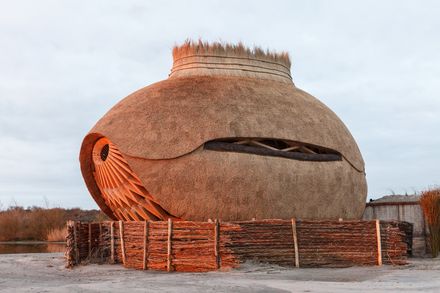CATEGORY
Other
PROJECT YEAR
2019
MANUFACTURERS
Accoya, Wood, McNeel
ENGINEERING
Geometria, BREED Integrated Design
LANDSCAPE
HNS Landscape Architects
CLIENTS
Vogelbescherming Nederland, Natuurmonumenten
COLLABORATORS
Van Hese Infra
CITY
Stellendam
COUNTRY
The Netherlands
Text description provided by architect.
Tij (name explanation: This is a Dutch word joke. ‘TIJ’ means ‘tide’ which refers to the returning tides in the Haringvliet, but quickly pronounced it also means ‘the egg’) Tij is the biggest and most striking of a series of objects designed to celebrate the opening of the Haringvliet sluices in November 2018.
The sluices were opened in order to improve water quality and biodiversity, while also stimulating fish migration from the North Sea to the river delta system of Maas and Rhine in the Netherlands.
This will create a new, salt-resistant and salt-loving natural environment. The biodiversity in the surrounding nature reserves will increase and a more robust, healthier ecosystem will develop in the coming years.
To let people experience and explore these changes, a series of bird observatories have been designed in the Haringvliet area. Tij is an egg-shaped bird hide situated in Scheelhoek, a nature reserve close to the Haringvliet sluice near Stelledam, the Netherlands.
To let people experience and explore these changes, a series of bird observatories have been designed in the Haringvliet area. Tij is an egg-shaped bird hide situated in Scheelhoek, a nature reserve close to the Haringvliet sluice near Stelledam, the Netherlands.
Tij observatory is part of a large scale landscaping plan where people can experience the Scheelhoek nature reserve in a walk from the car parking area to the Ei.
Walking along the path, visitors can view several types of bird biotope favoured by sand martins, several kind of waders and, of course, terns.
To prevent the birds from being disturbed, the last section of the path is actually a tunnel made of re-used mooring posts and second-hand azobe planks which were once used in the brick industry.
The tunnel is covered in sand to provide habitat for terns or waders. The outside of the tunnel provides artificial nesting holes for sand martins.
The egg itself is modelled on a sandwich tern egg, and sits on a nest of sand, much like a tern would have done it herself.
The nest of the egg consists of vertical ‘feathers’ of chestnut poles, reeds and small sand dunes.
The egg itself is parametrically designed to achieve a good ratio between form, structural integrity, size of the timber, and size of the openings.
The structure has been constructed as a File-to-Factory Zollinger to provide relatively big spans with small timber parts.
The lower part of the egg, which floods a few times a year, is made of accoya. The upper part, which stays dry all year, is made of pine. The upper part is thatched with local reed, harvested from the inside of the sea defences.
The thatched roof stops just above the highest possible water line. The floor inside the egg is a hybrid wood (CLT)- concrete floor which acts as a structural stabiliser and from where there is a beautiful view of the surrounding islands, the Haringvliet sluices and the water.
Tij is thatched with local reed and has a timber structure which has been completely File-to-Factory produced in 402 parts and has been assembled at the site. It can be completely dissembled.
Through its re-usability, its modularity, its materials and its contribution to the nature environment, it is almost completely circular and sustainable.
Reflecting the transitory nature of all things, it must also be noted that the Bird-EI is also temporary and will be taken apart at some point in the future.
At that time, it may be reused or recycled without detrimental effects to nature or man.In this way, we have created an (eco)system where man and nature can come closer together and be a part of each other’s world.





































